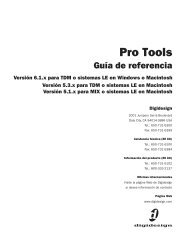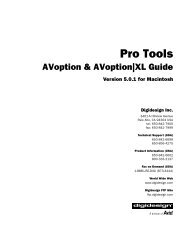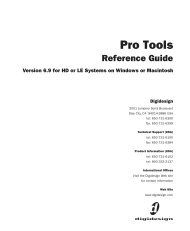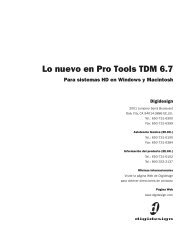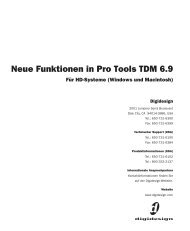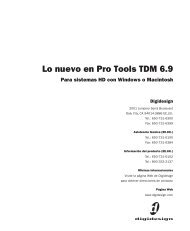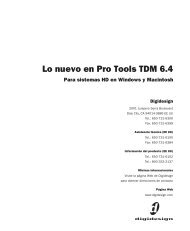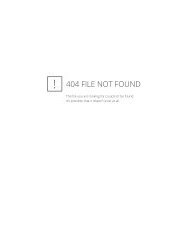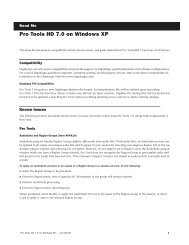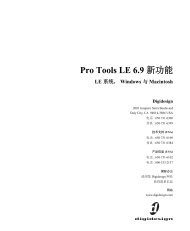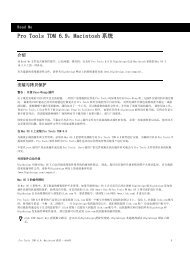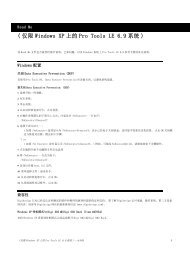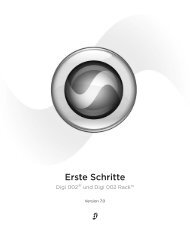5.1 DigiRack Plug-Ins Guide - Digidesign Support Archives
5.1 DigiRack Plug-Ins Guide - Digidesign Support Archives
5.1 DigiRack Plug-Ins Guide - Digidesign Support Archives
You also want an ePaper? Increase the reach of your titles
YUMPU automatically turns print PDFs into web optimized ePapers that Google loves.
38<br />
The most common application of dithering is to<br />
use it on a master output mix as the last processor<br />
in the signal path when preparing a 24-bit<br />
session for CD mastering. In this case, you<br />
would place the Dither plug-in on a Master<br />
Fader as a post-fader <strong>Ins</strong>ert to reduce session bitdepth<br />
from 24-bits to 16-bits.<br />
The Dither plug-in has user-selectable bit resolution<br />
and a noise shaping on/off option.<br />
If you are outputting audio to an analog<br />
destination with a 24-bit-capable Pro Tools<br />
system and an 888/24 I/O, do not use<br />
dither. This allows maximum output fidelity<br />
from the 888/24 I/O’s high-performance<br />
24-bit digital-to-analog convertors.<br />
Noise Shaping<br />
The Dither plug-in features a technique known<br />
as noise shaping to further improve audio performance<br />
and reduce perceived noise in lowlevel<br />
signals. Noise shaping utilizes digital filtering<br />
to remove noise that falls in the middle of<br />
the audio spectrum (specifically, around 4 kHz).<br />
This is the range where human hearing is most<br />
sensitive.<br />
In reality, since the noise plays an important<br />
role in reducing quantization errors (and<br />
thereby audio artifacts) the noise is not reduced<br />
in total, but is shifted into a range where it is<br />
harder to hear. Essentially, noise shaping lessens<br />
our perception of the noise inherent in dithering<br />
schemes by shifting audible noise components<br />
into a less audible range.<br />
<strong>DigiRack</strong> <strong>Plug</strong>-<strong>Ins</strong> <strong>Guide</strong><br />
Dither and Output Bit Resolution<br />
Dither has two user-selectable parameters that<br />
allow you to optimize its operation:<br />
Bit Resolution<br />
This pop-up menu allows you to choose one of<br />
three possible resolutions for the Dither processing.<br />
As a general rule, you should set this parameter<br />
to the maximum bit resolution of your destination.<br />
16-bit Recommended for output to digital devices<br />
such as DAT recorders and CD recorders,<br />
since they have a maximum resolution of 16bits.<br />
18-bit Recommended for output to analog devices<br />
if you are using an 888 I/O or 882 I/O Audio<br />
Interface since this is the maximum resolution<br />
available from the 18-bit digital-to-analog<br />
convertors of these devices.<br />
20-bit Recommended for output to digital devices<br />
that support a full 20-bit recording data<br />
path, such the Sony PCM-9000 optical mastering<br />
recorder, or the Alesis ADAT XT 20. This setting<br />
is also recommended for output to analog<br />
devices if you are using an 882/20 I/O Audio Interface.<br />
The 20-bit setting can also be used with<br />
digital effects devices that support 20-bit input<br />
and output, since it provides for a lower noise<br />
floor and greater dynamic range when mixing<br />
20-bit signals directly into the TDM environment.<br />
If you want, you can choose not to use the<br />
Dither plug-in and instead utilize the full 24-bit<br />
resolution of Pro Tools’ digital output, depending<br />
on your destination device. As noted previously,<br />
if you have a 24-bit-capable Pro Tools system<br />
with an 888/24 I/O Audio Interface and are<br />
outputting audio to an analog destination, we<br />
recommend that you do not use dither.



